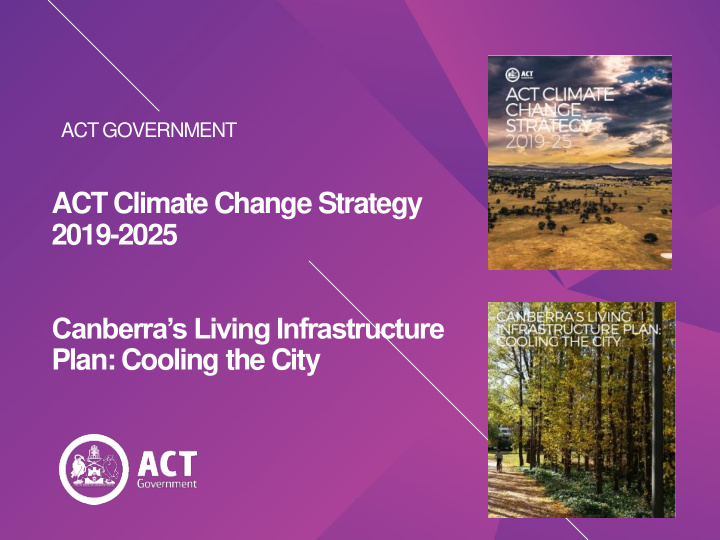



ACT GOVERNMENT ACT Climate Change Strategy 2019-2025 Canberra’s Living Infrastructure Plan: Cooling the City
Local climate change impacts Globally, July 2019 was the hottest month on record , with extreme temperatures and extended heatwaves across the Northern Hemisphere
Building a resilient, net zero emissions city
ACT legislated emissions reduction targets
ACT emissions 2012-13 and 2019-20: Increasing focus on gas and transport Total Total 1918 kt CO2-e 4042 kt CO2-e
A new climate strategy for the ACT • Mitigation, adaptation and just transition • Integrates with new Planning, Housing and Transport Strategies • Broad community and business participation/partnerships needed • Build low-carbon economic sectors • Evolutionary responses
Transport • Deliver a zero emissions Transport Canberra bus fleet by 2040 • Encourage active travel through improved routes and infrastructure • Implement car free days and consider car free areas and shared zones • Improve public transport services and adopt emerging smart cities technologies • Support bike share schemes • Explore and trial financial incentives for zero emissions vehicles and electric bikes
Zero Emissions Vehicles Action Plan • Strategy builds on our achievements and increases ambition • Have installed 46 charging stations for Government fleet vehicles • Currently 31 zero emissions vehicles in our fleet, will increase to over 80 by mid-2020 • An additional 20 hydrogen vehicles in 2020 • Helping to transform the market and make zero emissions vehicles more widely available
Energy, buildings and planning • Maintain 100% renewable electricity from 2020 • Remove requirement for gas connections in new suburbs • Develop a plan for achieving zero emissions from gas by 2045 • Design and commit to timeframe for implementing higher minimum energy performance and climate resilience standards for new buildings • Trial incentives for all-electric high efficiency apartment buildings
ACT Government leadership • Meeting targets without purchasing carbon offsets • Zero Emissions Government Framework includes commitments to – Reduce Government emissions by over 33% from 2020 to 2025 and to zero by 2040 – Adopt a “social cost of carbon” for Government emissions from 2025 – A zero emissions Transport Canberra bus fleet by 2040 – Ensure all newly leased/built Government buildings are all-electric – Establish pathways to zero emissions schools and hospitals • Sustainability ratings for capital works projects over $10 million
Waste avoidance and management • Introduce food and garden waste collection for all households from 2023 • Develop and consult on a scheme for requiring large organic waste producers such as hospitality and food retail to have separate organic waste collection • Support food rescue organisations • Investigate options for reducing emissions from organic waste treatment including sewage
Innovation and increasing ambition • Work with industry to support innovation, research and partnerships for a net zero emissions economy • Investigate opportunities for negative emissions technologies in the ACT • Reduce scope 3 (embodied emissions) through influencing consumer choices and supply chains and identify new opportunities for increased ambition
Breaking new ground and leading the nation Under this plan, the ACT is the FIRST Australian state or territory government to commit to… • Transitioning to a zero emissions bus fleet by 2040 • Commit to phasing out gas by 2045 • Adopting a social cost of carbon for emissions • Meeting emission reduction targets without the purchase of offsets • All new Government buildings being all-electric (and so zero- emissions) • All new public schools being all-electric and so zero- emissions)
Breaking new ground and leading the nation - 2 … • Transitioning to a zero emissions government passenger vehicle fleet • Developing a pathway to zero emissions hospitals • First Australian jurisdiction to legislate and achieve 100% renewable electricity from 2020 (with interim targets) • First jurisdiction to allow EEIS to covert transport, insulation, cover priority low income houses , etc…
Just transition • Measures to support renters and low income households (in buildings section): – Introduce minimum energy performance requirements for rental properties and mandatory disclosure of energy ratings – Ensure all new public housing is efficient all- electric, and upgrade existing public housing properties to efficient electric appliances – Provide tailored energy efficiency advice for renters – Facilitate access to zero, or low, interest loans for energy efficiency upgrades – Continue the Solar for Low Income program • Support vulnerable people and support re-training of workers where needed
Canberra’s Living Infrastructure Plan: Cooling the City
Urban heat mapping in Canberra • Built-up areas are around 8°C warmer in summer than surrounding rural areas • Temperatures vary as much as 10°C in suburban areas • Areas with above average surface temperature characterised by: • Impervious surfaces • Few trees Meyers J, Devereux D, Van Niel T and Barnett G (2017) Mapping surface urban heat in Canberra. CSIRO, Australia.
Canberra’s Living Infrastructure Plan: Key actions • 30% canopy cover (or equivalent) and 30% surface permeability by 2045 • Accounting for living infrastructure • Microclimate Assessments • Urban Forest Strategy • City Cooling Program • Oasis Program • Community Resources
Benefits of living infrastructure • The ACT Government and community want Canberra to be a sustainable, productive and equitable city which is resilient to the challenges of climate change and is a ‘city in the landscape’, drawing on its ‘bush capital’ and ‘garden city’ legacy Social and health, economic and environmental benefits of living infrastructure
Community leadership • Expand the scope of the Community Zero Emissions Grants • Provide tools and resources and a dedicated community liaison officer on climate change • Community to share ideas for improvements to the Strategy and Living Infrastructure Plan via online platforms
Working together for a better future • Together we can make Canberra a world leading net zero emissions city that demonstrates that a healthier, smarter future is possible • Find out more at www.act.gov.au/climatechange
Recommend
More recommend